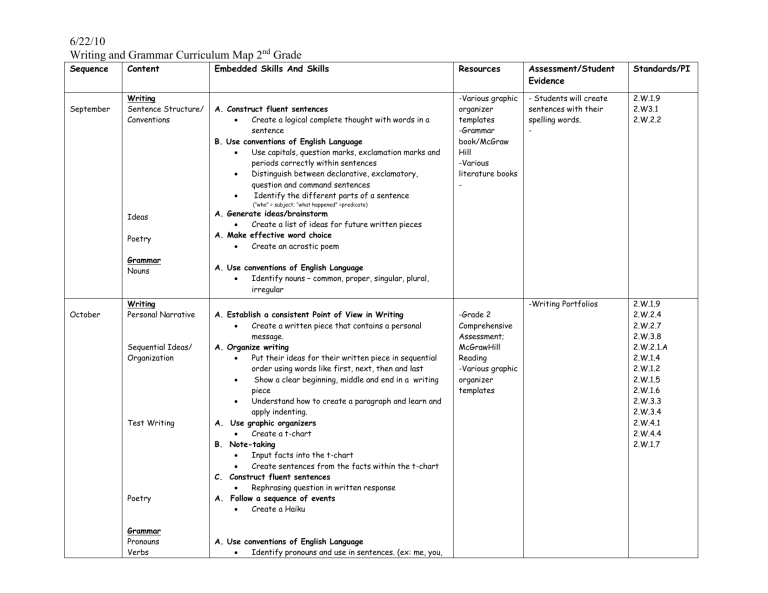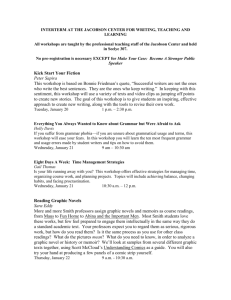Writing and Grammar Curriculum Map 2nd Grade

6/22/10
Writing and Grammar Curriculum Map 2 nd
Grade
Sequence Content Embedded Skills And Skills
September
October
Test Writing
Poetry
Grammar
Pronouns
Verbs
Writing
Sentence Structure/
Conventions
Ideas
Poetry
Grammar
Nouns
Writing
Personal Narrative
Sequential Ideas/
Organization
A. Construct fluent sentences
Create a logical complete thought with words in a sentence
B. Use conventions of English Language
Use capitals, question marks, exclamation marks and periods correctly within sentences
Distinguish between declarative, exclamatory, question and command sentences
Identify the different parts of a sentence
(“who” = subject; “what happened” =predicate)
A. Generate ideas/brainstorm
Create a list of ideas for future written pieces
A. Make effective word choice
Create an acrostic poem
A. Use conventions of English Language
Identify nouns – common, proper, singular, plural, irregular
A. Establish a consistent Point of View in Writing
Create a written piece that contains a personal message.
A. Organize writing
Put their ideas for their written piece in sequential order using words like first, next, then and last
Show a clear beginning, middle and end in a writing piece
Understand how to create a paragraph and learn and apply indenting.
A. Use graphic organizers
Create a t-chart
B. Note-taking
Input facts into the t-chart
Create sentences from the facts within the t-chart
C. Construct fluent sentences
Rephrasing question in written response
A. Follow a sequence of events
Create a Haiku
A. Use conventions of English Language
Identify pronouns and use in sentences. (ex: me, you,
Resources
-Various graphic organizer templates
-Grammar book/McGraw
Hill
-Various literature books
-
Assessment/Student
Evidence
- Students will create sentences with their spelling words.
-
-Grade 2
Comprehensive
Assessment;
McGrawHill
Reading
-Various graphic organizer templates
-Writing Portfolios
Standards/PI
2.W.1.9
2.W3.1
2.W.2.2
2.W.1.9
2.W.2.4
2.W.2.7
2.W.3.8
2.W.2.1.A
2.W.1.4
2.W.1.2
2.W.1.5
2.W.1.6
2.W.3.3
2.W.3.4
2.W.4.1
2.W.4.4
2.W.1.7
6/22/10
November/
December
January
Writing
Descriptive writing
Word Choice
Poetry
Grammar
Verbs
Adjectives
Conjunctions
Prefix/Suffix
Writing
Explanatory Writing
Grammar he, they….)
Identify verbs in a sentence
A. Establish a consistent point of view in writing
Create a developed story on a focused topic that includes supporting details
Use a topic sentence to begin a writing piece
A. Make effective word choices
Choose appropriate words for a given writing topic
Use a variety of words to show rather than tell in writing to create meaning
Notice when authors use words and phrases that create vivid pictures that linger in their minds such as
Kevin Henkes and Robert Munsch
A. Use sophisticated vocabulary
Identify and replace worn out/tired words with fresh and active words
Create a couplet using the skill of rhyming words
A. Use conventions of English language
Identify past, present and future tense of verbs
Tell difference between verbs of being and verbs of action.
Apply word endings learned in phonics for sentence fluency
Identify describing words in sentences
Use commas to separate adjectives in sets
Differentiate adjectives that tell what kind/how many
Use adjectives to compare using er, est
Use conjunctions to join sentences with similar ideas
Recognize and apply prefixes and suffixes (such as re, un, dis, ful, ment, ly, ness, etc. )
A. Organize writing
Create a focused, interesting piece on a “How to” process with all relevant details.
Evaluate the content of a written piece by identifying important and unimportant details.
Write on a topic that compares and contrasts
Write in paragraphs
A. Uses conventions of English conventions
-Various graphic organizer templates
-Various graphic organizer templates
2.W.2.1.C
2.W.3.6
2.W.2.1.B
2.W.3.6
2.W.3.5
2.W.1.4
2.W.2.5
2.W.1.1
2.W.1.2
2.W.3.2
2.W.4.2
2.W.2.1B
2.W.3.7
2.W.1.8
6/22/10
February
March /
April
May/
June
Poetry
Synonyms/Antonyms
Writing
Expository Writing
Poetry
Friendly Letter
Grammar
Adverbs
Writing
Persuasive Writing
Writer’s Voice
Poetry
Grammar
Homophones
Writing
Imaginative Writing
Poetry
Create a cinquain poetry
Recognize and apply synonyms and antonyms
A. Construct a thesis and support with fact.
Create a focused piece on a non-fiction topic that seeks to inform, explain, or instruct.
A. Organize writing
Create a shape poem.
Create a diamante
B. Effective writer’s voice
Create a song poem.
A. Construct fluent sentences
Be introduced to the parts of a friendly letter.
Create a friendly letter along with addressing an envelope.
A. Use of conventions of English language.
Identify words that describe a verb.
Differentiate between adverbs that tell: how, when and where
A. Establish a consistent Point of View in Writing
Create a writing piece that aims to convince the reader to take the writer’s side.
A. Use effective writer’s voice
Write in a way that fits the audience best. (Writing to the principal vs. writing to a friend)
A. Make effective word choices
Create a limerick
A. Uses of conventions of English language.
Learn that homophones are words that sound the same but have different meanings and spellings.
A. Uses sophisticated vocabulary
Write an inventive story that can mix fantasy and reality, which is spirited, lively, and travels new roads of student thought.
Thesaurus
A. Generate ideas/Brainstorm Organize Writing
Create a narrative poem.
-Various graphic organizer templates
-Various graphic organizer templates
-Various graphic organizer templates
2.W.1.1
2.W.1.2
2.W.3.1
2.W.3.2
2.W.2.1B
2.W.2.6
2.W.4.3
2.W.4.2
2.W.2.1C
2.W.2.3
2.W.2.4
2.W.2.0
6/22/10






